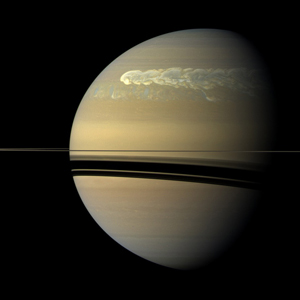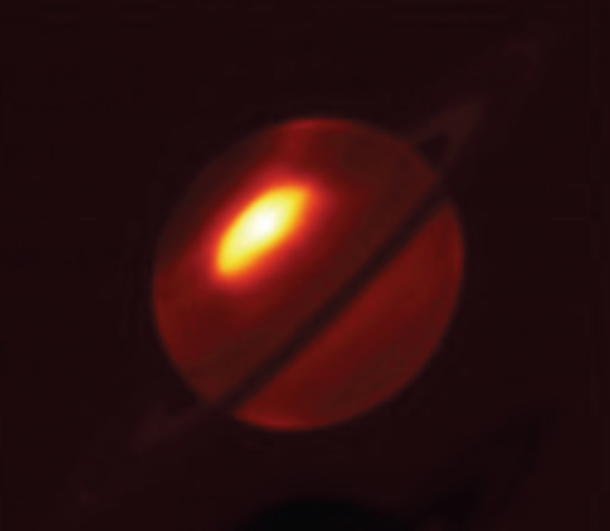Create a free profile to get unlimited access to exclusive videos, sweepstakes, and more!
Saturn storm cranks the heat WAY up

 In late 2010, amateur astronomers discovered a white spot on Saturn - a gigantic storm forming in its northern hemisphere. The storm grew rapidly, and within weeks had embiggened to an almost unbelievable size, much larger than our entire planet. The winds in Saturn's atmosphere sheared the storm, pulling it apart while it still raged, and after three months the storm had wrapped completely around the planet, stretched to the ridiculous length of 300,000 km (180,000 miles) - 3/4 of the distance from the Earth to the Moon!
In late 2010, amateur astronomers discovered a white spot on Saturn - a gigantic storm forming in its northern hemisphere. The storm grew rapidly, and within weeks had embiggened to an almost unbelievable size, much larger than our entire planet. The winds in Saturn's atmosphere sheared the storm, pulling it apart while it still raged, and after three months the storm had wrapped completely around the planet, stretched to the ridiculous length of 300,000 km (180,000 miles) - 3/4 of the distance from the Earth to the Moon!
By mid-2011 the storm had nearly subsided - its remnants could still be seen in images taken by the Cassini spacecraft orbiting the ringed world - but the teeth had been taken out of it. Still, there was one surprise left in it.
Observations taken in the infrared by Cassini as well as from Earth show that the storm was not just big and violent, it also formed a vortex (a storm within a storm, if you like) that got hot - well, hot for frigid Saturn, that is. In the heart of the system, the temperature rose by an incredible 80° Celsius - a difference in temperature that's like starting in the depths of winter in Anchorage, Alaska and then going to the height of summer in the Sahara!
The image here [click to encronosenate] is from the Very Large Telescope in Chile, and was taken in the infrared, where the heat in the vortex is fairly obvious. Mind you, it's not like it was a firestorm: the maximum temperature was still a chilly -150° Celsius, but compared to Saturn's usual -220 or so degrees, that's pretty dang hot.
The rise in temperature was unexpected. A 20° rise is about the usual fare for these things, but then, this wasn't a usual storm. Apparently, this hot spot started as two separate vortices, spawned by the storm seen in visible light, and moving around the planet at slightly different speeds. They eventually merged, forming this one ginormous vortex, which at its biggest was over 62,000 km (38,000 miles) across. Interestingly, it grew to this size around the time the visible storm had faded away.
Here's a video from NASA's Goddard Space Flight Center featuring planetary scientist Brigette Hesman describing the event:
Like any planet with an active atmosphere, storms on Saturn are common, but one this big had never been seen before. I'd say it was fortunate that we had a spacecraft like Cassini orbiting the planet when the storm erupted, but luck had very little to do with it: it was hard work and dedication that gave us that view. Cassini is such a well-crafted machine that it has operated nearly flawlessly for over eight years orbiting the distant planet. Its design and launch took decades to complete, and it took another seven years just to get to Saturn in the first place.
My point? Luck favors those who are prepared and have planned for rare circumstance. A storm like this one may not happen very often, but we were ready for it by having Cassini there in the first place, and by having a fleet of Earth-based telescopes with their eyes on the sky to support it.
... and having said that, I'll note an irony: although it was right there, Cassini didn't discover the storm in the first place. Why not? Because there's just too damn much to see in the Saturn system! The storm erupted rapidly, and Cassini was busy looking at the rings and moons, so it missed the storm's genesis. This is not a failure on the part of Cassini or its designers and users: instead, it should be seen as a clarion call for more spacecraft, more explorers in our solar system observing all the myriad worlds.
When I see images and science like this, I am filled with awe and joy, but I'm also struck with an implacable thought: what else are we missing?
Image credit: Leigh N. Fletcher, University of Oxford, UK, and ESO; NASA/JPL-Caltech/SSI
Related Posts:
- A Saturnian storm larger than worlds
- A storm wraps around Saturn
- Psychedelic Saturn storm!
- Saturn broods while a storm dissipates
- Lightning strikes in a storm bigger than worlds



























